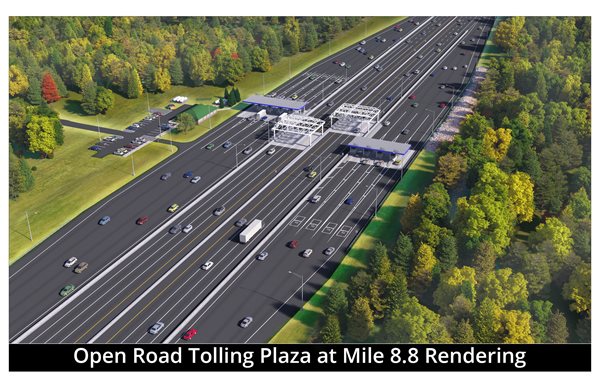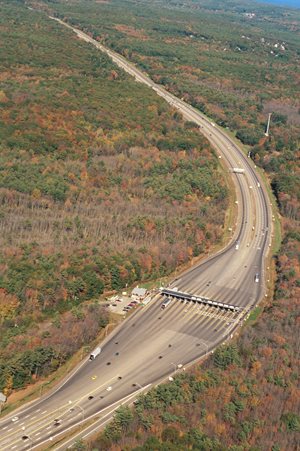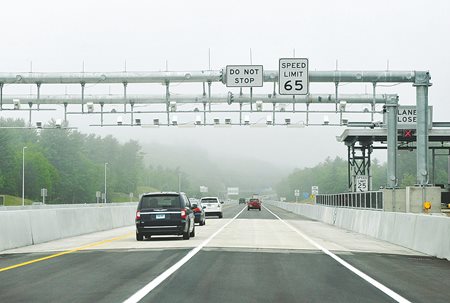 Permits Issued:
Permits Issued:
- Federal - USACE 5/18/17
- State - MaineDEP 9/14/17
York Permit Applications:
Other Permitting Related Materials:
Materials Related to Toll Collection Methodology:
Documents pertaining to Jacobs Review of Current Plaza - Mile 7.3:
Documents pertaining to Selection of the Mile 8.8 Site:
Archival Records
Frequently Asked Questions
Why is this project needed?

The York Toll Plaza is one of the most important pieces of transportation infrastructure in the State. It is the gateway to Maine, generates about $56 million in toll revenue per year, and is a central reason why two-thirds of all MTA revenue is paid by out-of-staters.
The existing plaza is old and needs replacing. It originally was designed in the 1960’s as a temporary barrier plaza for all vehicles to stop to take tickets and pay tolls, has approaches sinking into clay soils, has a leaking tunnel full of electrical components, and has outdated toll equipment held together with used parts. Further, it is located on a curve at the bottom of a hill near an interchange and overpass, which raises safety concerns.
Moreover, the current plaza does not provide the modern, open, highway speed electronic tolling that travelers now expect and deserve. For all these reasons, the MTA has been working to deliver this project to Maine travelers for over ten years.
Given the need, why isn’t the project done already?
Because there has been an extended debate on the appropriate scope and location of the project. Many years ago, tolling experts recommended that Open Road Tolling (ORT) was the proper solution at York. ORT has highway speed center lanes and cash lanes to the right like what exists now on I-95 in Hampton, New Hampshire. Many wanted more consideration of whether cash toll collection could be eliminated with All Electronic Tolling (AET).
After a second expert tolling opinion, it was confirmed that AET is not feasible at York because it would require cash toll rates to initially double from $3 to $6 to compensate for lost revenue from toll violations and from diversion, estimated at an additional 3,400 to 5,500 vehicles per day, which would snarl already busy local and state roads.
What do experts say about the existing site?
In August of 2014, the MTA contracted with another experienced and well-respected engineering firm, Jacobs Engineering (www.Jacobs.com), to take another look at what it would take to build an ORT plaza near the existing toll plaza at Mile 7.3. In early 2015, Jacobs determined that with significant engineering and environmental trade-offs, it would be technically feasible to build it there at an estimated cost of $60 million. This option is favored by local residents.
So why not just build the new plaza at the Mile 7.3 site?
Although the opinions of York residents are important, the MTA has legal and fiduciary obligations to all of Maine – including the 62 million travelers who use and pay for the Turnpike every year – to look for sites that are more safe, affordable, constructible, and environmentally sensitive. In June 2015, Jacobs concluded that a site near Mile 8.8 was a superior option. In November 2015, the MTA Board determined that the MTA should proceed with further design and permitting at Mile 8.8.
Why is the Mile 8.8 site superior?
Mile 8.8 is superior because it would be safer, would have much less wetland and stream impact, would be less disruptive to travelers, toll collectors, and abutters, and would cost about $20 million less.

• Professional Engineers experienced in the design of interstate highways and toll plazas have determined that Mile 8.8 would be safer and more efficient because it is located on a straight section at the crest of a hill, away from interchanges and has good visibility for approaching vehicles. There would be less braking, confusion and weaving there, and thus fewer accidents and less noise. Further, all lanes would be used more fully, thus easing congestion.
- Mile 8.8 would have about 80% less wetland and stream impact than Mile 7.3. Further, experts have determined that the wetlands at Mile 8.8 have lower function and value than those at Mile 7.3.
- Mile 8.8 will take significantly less time to build. The Mile 7.3 site would cause much more disruption to travelers and toll collectors, and would cause significant toll revenue losses due to diversion.
- Like all sites being considered by the MTA Board, the Mile 8.8 site would not displace any home. In fact, there are only 4 houses within 1,000 feet of the proposed project there, compared to 47 houses within 1,000 feet of a proposed project at Mile 7.3.
- Mile 8.8 would cost about $20 million less to build ($40 million vs. $60 million).
What are the next steps for this project?
Construction started in late 2018 lead by Maine Contractor Reed & Reed from Woolwich Maine. Construction is expected to take until mid 2021. More information on construction can be found
here